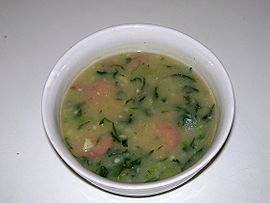
Caldo verde
Encyclopedia

Soup
Soup is a generally warm food that is made by combining ingredients such as meat and vegetables with stock, juice, water, or another liquid. Hot soups are additionally characterized by boiling solid ingredients in liquids in a pot until the flavors are extracted, forming a broth.Traditionally,...
in Portuguese cuisine
Portuguese cuisine
Portuguese cuisine is characterised by rich, filling and full-flavored dishes and is closely related to Mediterranean cuisine. The influence of Portugal's former colonial possessions is also notable, especially in the wide variety of spices used. These spices include piri piri and black pepper, as...
.
The basic ingredients for caldo verde are potato
Potato
The potato is a starchy, tuberous crop from the perennial Solanum tuberosum of the Solanaceae family . The word potato may refer to the plant itself as well as the edible tuber. In the region of the Andes, there are some other closely related cultivated potato species...
es, onion
Onion
The onion , also known as the bulb onion, common onion and garden onion, is the most widely cultivated species of the genus Allium. The genus Allium also contains a number of other species variously referred to as onions and cultivated for food, such as the Japanese bunching onion The onion...
s and kale
Kale
Kale is very high in beta carotene, vitamin K, vitamin C, lutein, zeaxanthin, and reasonably rich in calcium. Kale, as with broccoli and other brassicas, contains sulforaphane , a chemical with potent anti-cancer properties. Boiling decreases the level of sulforaphane; however, steaming,...
(some recipes call for collard greens
Collard greens
Collard greens are various loose-leafed cultivars of Brassica oleracea , the same species as cabbage and broccoli. The plant is grown for its large, dark-colored, edible leaves and as a garden ornamental, mainly in Brazil, Portugal, the southern United States, many parts of Africa, Montenegro,...
instead). Common additional ingredients are garlic
Garlic
Allium sativum, commonly known as garlic, is a species in the onion genus, Allium. Its close relatives include the onion, shallot, leek, chive, and rakkyo. Dating back over 6,000 years, garlic is native to central Asia, and has long been a staple in the Mediterranean region, as well as a frequent...
, salt
Salt
In chemistry, salts are ionic compounds that result from the neutralization reaction of an acid and a base. They are composed of cations and anions so that the product is electrically neutral...
, and olive oil
Olive oil
Olive oil is an oil obtained from the olive , a traditional tree crop of the Mediterranean Basin. It is commonly used in cooking, cosmetics, pharmaceuticals, and soaps and as a fuel for traditional oil lamps...
. Some recipes add meat
Meat
Meat is animal flesh that is used as food. Most often, this means the skeletal muscle and associated fat and other tissues, but it may also describe other edible tissues such as organs and offal...
. The soup is often accompanied by slices of chouriço
Chorizo
Chorizo is a term encompassing several types of pork sausages originating from the Iberian Peninsula.In English, it is usually pronounced , , or , but sometimes ....
or linguiça
Linguiça
Linguiça is a form of Portuguese smoke cured pork sausage seasoned with garlic and paprika.Outside of Portugal, Azores and Brazil, linguiça is also popular in Goa , Southeastern Massachusetts, Massachusetts' North Shore, California, Rhode Island, Hawaii, and Okinawa, where it is often simply...
, or with Portuguese broa
Broa
Broa is a type of cornbread traditionally made in Portugal and Galicia . Unlike the cornbread typical of the southern United States, broa is made from a mixture of cornmeal and wheat or rye flour, and is leavened with yeast rather than baking powder or baking soda.This yeast bread has the...
cornbread
Cornbread
Cornbread is a generic name for any number of quick breads containing cornmeal and leavened by baking powder.-History:Native Americans were using ground corn for food thousands of years before European explorers arrived in the New World...
for dipping. In Portugal, caldo verde is typically consumed during Portuguese
Portuguese people
The Portuguese are a nation and ethnic group native to the country of Portugal, in the west of the Iberian peninsula of south-west Europe. Their language is Portuguese, and Roman Catholicism is the predominant religion....
celebrations, such as wedding
Wedding
A wedding is the ceremony in which two people are united in marriage or a similar institution. Wedding traditions and customs vary greatly between cultures, ethnic groups, religions, countries, and social classes...
s. It is sometimes consumed before a main course meal
Meal
A meal is an instance of eating, specifically one that takes place at a specific time and includes specific, prepared food.Meals occur primarily at homes, restaurants, and cafeterias, but may occur anywhere. Regular meals occur on a daily basis, typically several times a day...
or as a late supper
Supper
Supper is the name for the evening meal in some dialects of English - ordinarily the last meal of the day. Originally, in the Middle Ages, it referred to the lighter meal following dinner, where until the 18th century dinner was invariably eaten as the midday meal.The term is derived from the...
.
Caldo verde originated from the Minho Province in northern Portugal. Today, it is a traditional national favorite that has spread across the nation and abroad. References to the soup appear in many novels by Camilo Castelo Branco
Camilo Castelo Branco
Camilo Ferreira Botelho Castelo-Branco,1st Viscount de Correia Botelho , was a prolific Portuguese writer of the 19th century, having authored over 260 books . His writing is, overall, considered original in that it combines the dramatic and sentimental spirit of Romanticism with a highly personal...
.

